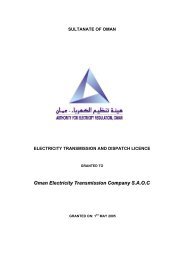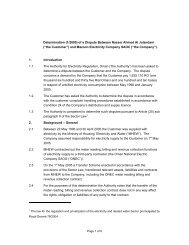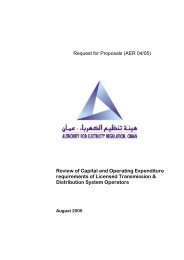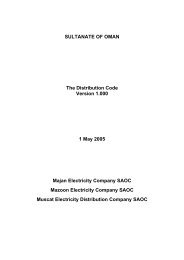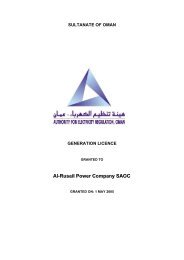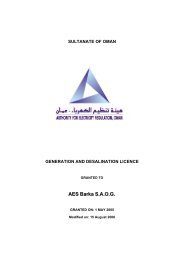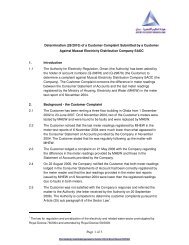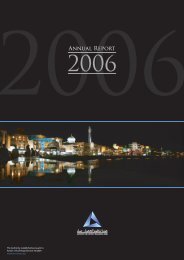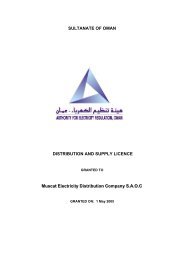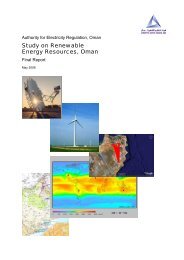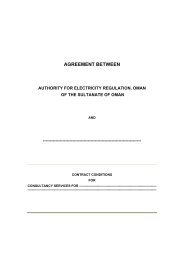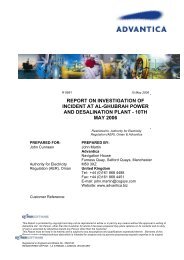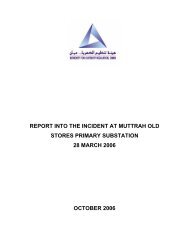Review Incident Shin.. - authority for electricity regulation, oman
Review Incident Shin.. - authority for electricity regulation, oman
Review Incident Shin.. - authority for electricity regulation, oman
Create successful ePaper yourself
Turn your PDF publications into a flip-book with our unique Google optimized e-Paper software.
We were told that the investment in a second circuit to the <strong>Shin</strong>as grid station was already<br />
planned during the time that the Ministry of Housing Electricity and Water was the operator<br />
of the transmission network, ie there were plans <strong>for</strong> a second circuit to <strong>Shin</strong>as be<strong>for</strong>e 1 May<br />
2005 3 . According to OETC’s investment plan <strong>for</strong> 2006 4 a second 132 kV-circuit to the <strong>Shin</strong>as<br />
grid station had been planned <strong>for</strong> construction in 2006. We understood from OETC 5<br />
that this project had been delayed because it was combined with the investment in a new<br />
grid station in Liwa, which increased the efficiency of this investment. OETC confirmed that<br />
the construction of a second circuit to <strong>Shin</strong>as is now in the tendering phase. However, we<br />
have not seen any proof of this.<br />
It can be concluded that if there had been a second 132 kV-circuit to <strong>Shin</strong>as, the fault would<br />
not, under normal operating conditions, have caused an outage since the second feeder<br />
would have been capable of supplying the entire load. For the peak demand of the <strong>Shin</strong>as<br />
area (65 MW <strong>for</strong>ecasted <strong>for</strong> 2007) this situation is unacceptable according to international<br />
and Oman standards. This has been recognized by OETC and its predecessors <strong>for</strong> many<br />
years (be<strong>for</strong>e 2005) and KEMA strongly recommend that the contract to provide <strong>for</strong> n-1 is<br />
implemented on an expedited basis.<br />
2.2. Preparedness <strong>for</strong> a fault in the Wadi Jizzi – <strong>Shin</strong>as line<br />
The reason why, in general, the (n-1) criterion is applied is that there is a reasonable risk<br />
that faults in lines, trans<strong>for</strong>mers, generators etc will occur. This risk combined with the<br />
damage of losing load results in the need to invest to provide additional redundancy of system<br />
elements e.g. lines, trans<strong>for</strong>mers etc. Security Standards allow <strong>for</strong> and even require<br />
large investments to provide (n-1) security in transmission networks.<br />
Following this logic, situations in which these standards are not met should be considered<br />
very seriously. For these situations in which a single fault will lead to an outage with significant<br />
loss of load <strong>for</strong> a long duration (the repair time) there should be detailed and comprehensive<br />
plans.<br />
Since it was recognized by OETC (see section 2.1) that the (n-1) security criterion was not<br />
met <strong>for</strong> the Wadi Jizzi – <strong>Shin</strong>as line, then there should have been a plan in place to deal<br />
3 1 May 2005 is the date OETC took over the responsibility of the transmission network.<br />
4 See section 7.2 of the ‘Report on capital and operating expenditure requirements <strong>for</strong> the<br />
Oman <strong>electricity</strong> Transmission Company <strong>for</strong> the period 2006 - 2010’, by SKM, July 2006.<br />
5 Interview on 1 September 2007.<br />
<strong>Review</strong> <strong>Incident</strong> <strong>Shin</strong>as August 2007 7 09.10.2007<br />
vs. 2 (final)



